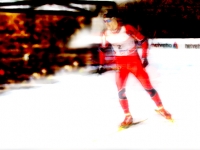Why am I writing about cross-country skiing right here? Relax, I’m just about to make my point...
The purpose of this maneuvre was to increase the athlete’s chance to take a better place in the overall standings and to gain a better position for the Norwegian team. The team manager confirmed in an interview with reporters that – “Before the race the girls agreed to behave in this way.”
The runners’ behaviour raised objections, even outrage among fans (of course, apart from the Norwegian fans). In many of the comments people even called for punishing the athlete who made way for her friend clearly, without a fight.
Infringement? I don’t know the exact rules of cross-country skiing, but I think that there is a paragraph saying simply that – “An athlete ought to follow their route from the start to finish so as to get to the finish line as soon as possible ...” Unless this particular point was considered obvious.
Certainly there are paragraphs prohibiting blocking and cutting in on opponents as well as other harmful maneuvres. But in this case we don’t deal with cutting in on anybody. The runner could also justify herself claiming that she was about to faint. So there is no reason to disqualify or punish her.
This case gives me a pretext to write about our “table” issues. We have penalties in armwrestling, first a warning, then a foul for specific offences. We know that two fouls mean the end of the fight for the penalized.
But – let’s consider a seemingly simple question. When does the fight start? It’s so simple! – You will all say at once.
In terms of rules, the fight starts after the competitors are called to the table by the announcer. Each competitor has time to appear at the table. If they don’t show up within a minute from the call, the referee may ask the speaker to call the name once again and add that this is the last call to the table.
Experience has shown that, depending on the rank of the competition, there are different approaches to the time given to appear at the table. At championships rules are strictly observed. At the local competitions, it happens that the “search” for a competitor lasts a little longer.
There is another point which is worth noting from the perspective of law. I mean, the moment when the competitors enter the stage. From that moment, they are subject to strict discipline of sportsmanship! Losing the fight and additional consequences might be a penalty for unsportsmanlike conduct at this point.
Let me explain this using an example. If a competitor behaves in an unsportsmanlike manner after the end of their participation in the event - they can be reprimanded or disqualified, but the results of this event will not be “erased”. However, if a competitor behaves unsportingly while they are on the stage, before, during, or at the end of the fight - it may be said that they lost the fight. Remember, the fight ends on the referee’s command “Stop!” But - the competitor must accept the verdict in a sportsmanlike manner, thank their opponent and leave the stage. Of course, there are no specified requirements. Nobody will punish the loser for making a gesture expressing their discontent. But for uttering words considered vulgar they might be punished. Similarly, the winner shouldn’t express their joy too “dramatically”, for example, showing contempt towards the defeated. We write it all “preventively” since the behaviour of armwrestlers is simply exemplary. The fights, in the case of which we deal with the above-mentioned situations, constitute less than one percent of the fights taking place all over the world.
May the example of the Norwegian runners that I’ve mentioned give us food for thought. What is and what is not “fair” behaviour during a competition?
Once upon a time, long time ago (nearly half a century) I came up with my own theory about that matter and I’d like to share it with you. I used to practise ice hockey and sailing.
Well: I’ll catch the opponent by the shirt and I put a stick at his feet. The referee will notice that and give me a penalty. I’m a loser and I get punished (me and the team). But if the referee doesn’t notice that, the opponent will fall over, I’ll take possession of the puck and initiate an attack- it doesn’t matter! The referee might have noticed that, but he didn’t. It’s his loss, my win. Devious reasoning, isn’t it?
Neither I nor my colleagues saw anything wrong in such behaviour. Anything which wouldn’t be “fair”.
However, what if there is no referee? It’s a totally different story. For example, during a sailing regatta the referee doesn’t see a lateral buoy due to poor visibility. In such a situation I would never take a short cut! Because it would be “unfair”.
Sometimes it is good to think about the various aspects of morality in sport. Just like that, on the New Year!
And one more thing. What REALLY angered me in the Norwegian athlete’s behaviour was this gesture of stopping on her way to the finish line. By doing that she’s shown disregard for her opponents. And disregard cannot be tolerated. By stopping she sent all the defeated the following message: - “I don’t even have to try, you are worse, I can even stop, and still you won’t catch me up!"
This is not fair!
Respect your opponent! In this way you respect yourself!
PeSzy

